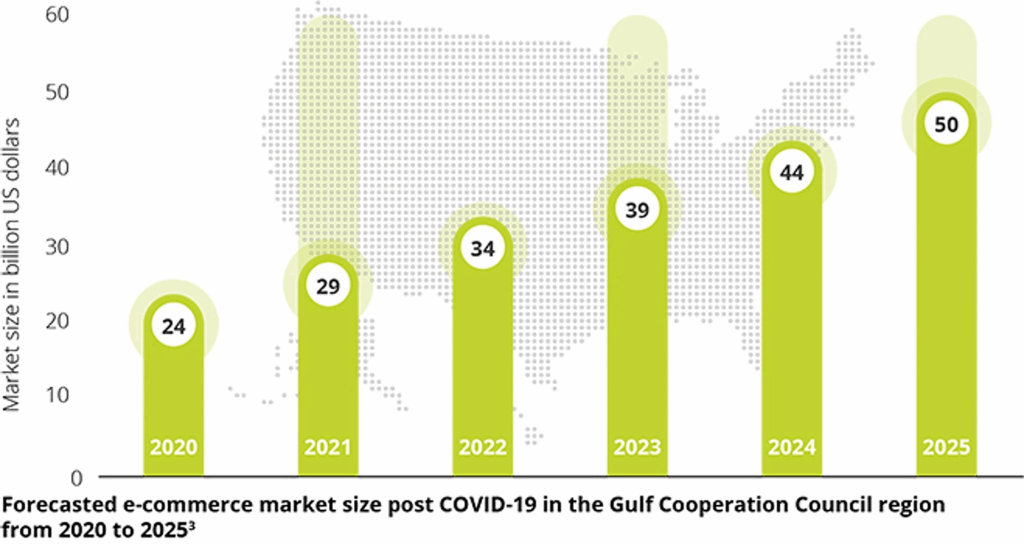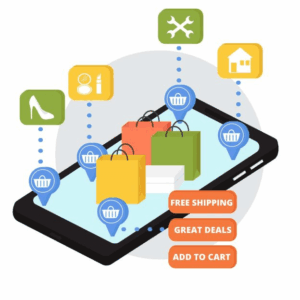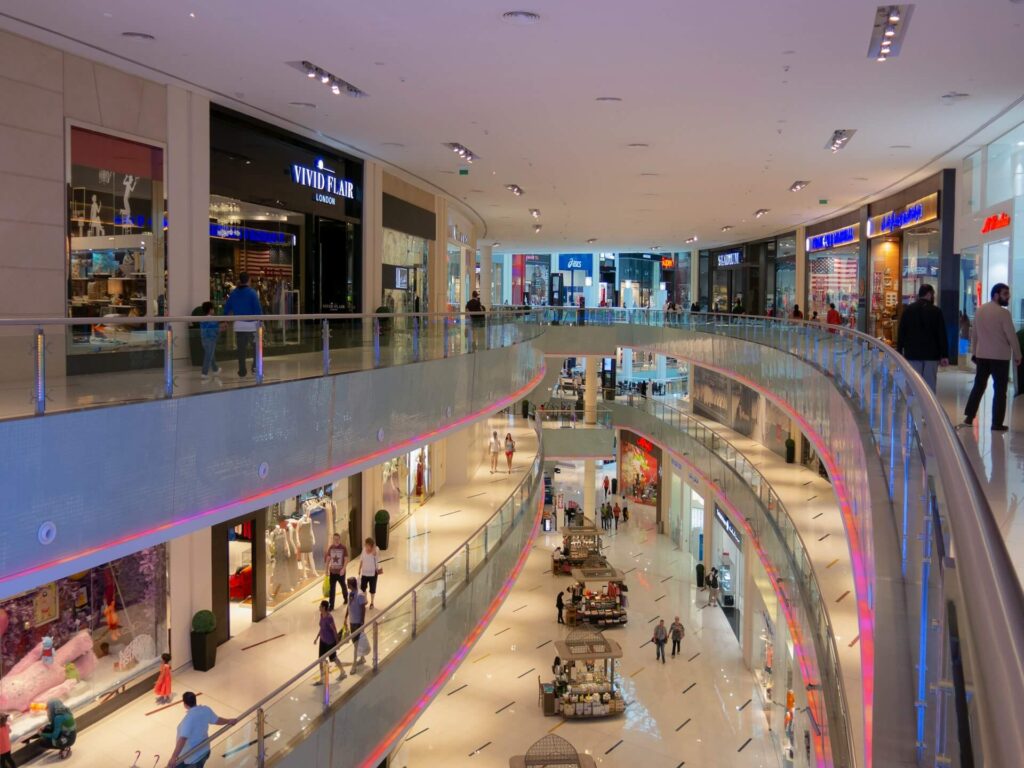eCommerce in the Middle East is no longer just “on the rise.” It’s here, growing fast, and changing the way people shop, sell, and build brands across the region. From Dubai and Riyadh to Cairo and Kuwait City, the digital marketplace is being shaped by mobile-first shoppers, local fintech innovation, and a new wave of consumer behavior.
In this blog, we’ll explore the key ecommerce trends in the Middle East in 2025, supported by real market data, local insights, and what it all means for founders, brands, and ecommerce startups.
Ecommerce Market in the Middle East (2025)
The ecommerce market in the Middle East is expected to surpass $80 billion by 2029, driven by digital adoption, a young population, and growing demand for convenience. Countries like the UAE, Saudi Arabia, Egypt, and Kuwait are leading the charge.
- Smartphone penetration is nearly universal in many parts of the region, with mobile commerce accounting for 66% of online purchases in the Middle East.
- Governments are supporting digital transformation under initiatives like Saudi Vision 2030 and the UAE’s Smart Government Strategy.
What makes this region especially interesting is the combination of high digital usage with rapid fintech innovation, fast logistics, and a growing middle class that’s willing to spend online.

Key eCommerce Trends in the Middle East
1. Mobile-First and App-Driven Commerce
Smartphones are the backbone of ecommerce in the region. In 2025, mobile-first shopping experiences are the norm, not the exception.
- Consumers prefer apps or mobile-optimized websites for ease of use and speed.
- Progressive Web Apps (PWAs) are also gaining traction, offering fast, app-like experiences without needing to download anything.
If you’re building an ecommerce brand in the Middle East, optimizing for mobile is non-negotiable.
2. Social Commerce & Live Shopping
Social media isn’t just where people discover brands anymore…it’s where they buy.
- Social commerce is expected to reach US$5.14 billion by 2029 in Saudi Arabia alone.
- Platforms like Instagram, TikTok, and WhatsApp are enabling seamless in-app purchases.
- Influencer-led “live shopping” events and user-generated content are becoming conversion goldmines.
In a region where trust and personal recommendations matter, social commerce is one of the fastest-growing channels.

3. Quick Commerce (Q-Commerce)
Q-commerce…delivering orders in under 60 minutes is gaining traction fast.
- Major logistics providers are investing heavily in dark stores and hyperlocal fulfillment centers.
- In cities like Riyadh and Dubai, same-day and next-day delivery are becoming the norm, not a premium service.
- DHL has committed over €500 million to expand logistics infrastructure in the Middle East.
This is a big opportunity for founders who can build efficient, fast-moving delivery models.
4. AI-Powered Personalization & Voice Commerce
Middle East shoppers expect a personalized experience.
- AI and machine learning are being used for product recommendations, chatbots, and inventory forecasting.
- Voice commerce is also starting to emerge, with brands experimenting with Arabic-language voice assistants.
- Platforms like Noon and Amazon are using AI to create faster, more intuitive user journeys.
This is especially powerful in a region with multilingual and culturally nuanced shoppers.
5. Omnichannel & Phygital Retail Experiences
Retail in the Middle East is becoming a blend of digital and physical touchpoints.
- Brands are using BOPIS (Buy Online, Pick Up In Store) models to increase flexibility.
- Pop-up stores, in-mall kiosks, and showrooming are bringing online brands into physical spaces.
- Unified CRM and inventory systems help create seamless customer experiences across all platforms.
If you’re building a brand, think of your ecommerce platform as the hub, not the whole wheel.

6. Payment Evolution: BNPL & Wallets
Payments are changing fast, and consumers are embracing flexible options.
- Buy Now, Pay Later (BNPL) services like Tabby, Tamara, and Valu are seeing massive adoption.
- Digital wallets and contactless payments are growing, especially among younger shoppers.
- Some regions are experimenting with crypto-enabled transactions, although this remains niche for now.
Offering flexible, familiar payment options is critical for conversion in this region.
7. Immersive Shopping: AR, VR & the Metaverse
Augmented and virtual reality are no longer experimental.
- UAE-based fashion and beauty brands are using AR for virtual try-ons.
- Some retailers are launching experiential storefronts in metaverse platforms like Roblox.
- These tools are especially effective in high-consideration categories like fashion, beauty, and home.
As consumers expect more interactive and immersive experiences, brands need to keep up.
8. Sustainability & Ethical Shopping
Eco-conscious shopping is on the rise, especially among Gen Z and Millennial consumers.
- Sustainable packaging, ethical sourcing, and carbon-neutral shipping are top priorities.
- Refurbished, second-hand, and slow fashion brands are gaining ground.
- There’s growing demand for halal beauty, organic products, and modest fashion.
Consumers care not just about what they’re buying, but how it got to them.
9. Security & Fraud Prevention
With growth comes risk, especially in payments and data.
- Ecommerce platforms in the region are stepping up their cybersecurity efforts.
- There’s a push for better fraud detection, secure checkout flows, and two-factor authentication.
- Building trust is essential, especially for cross-border or high-ticket purchases.
The winners in this space will combine convenience with airtight security.
Country Spotlights
UAE
- One of the most mature ecommerce ecosystems in the region.
- High mobile commerce share and early adopters of AR, Q-commerce, and crypto.
- Strong infrastructure and logistics make it a regional hub for digital retail.
Saudi Arabia
- The largest ecommerce market in MENA by size and spend.
- Vision 2030 is driving fintech and digital infrastructure investment.
- Social commerce and BNPL are particularly strong here.
Egypt
- Mobile-first shoppers and a rapidly growing fintech sector.
- Still reliant on cash-on-delivery, but digital wallets are catching up.
- Growing number of local DTC brands in fashion, beauty, and home goods.
What This Means for Founders & Brands
If you’re a founder looking to build or grow an ecommerce brand in the Middle East, here’s what to keep in mind:
- Go mobile-first
Apps, fast-loading sites, and mobile-friendly UX are critical. - Embrace social commerce
Use influencers, live shopping, and in-app checkouts. - Build for speed
Quick delivery, real-time support, and smooth checkout flows matter. - Offer flexible payments
BNPL, digital wallets, and local gateways improve conversion. - Personalize everything
Use AI to localize and customize the experience. - Think omnichannel
Connect your physical and digital worlds for better reach.
Final Thoughts
Ecommerce in the Middle East is actively transforming. From AI and AR to super-fast delivery and social shopping, the region is full of momentum and untapped opportunity.
The brands that will succeed here aren’t just the ones with the best product. They’re the ones that understand the local culture, adapt to fast-changing tech, and offer a seamless, trustworthy customer experience.
2025 is a defining year for eCommerce in the region. If you’re planning to build or grow your presence, now is the time to act.
Ready to Launch Your Ecommerce Brand in the Middle East?
At Hapy Co, we help founders and teams build mobile-first digital products that fit local markets and scale globally. From ecommerce stores to mobile apps and marketplaces, we design and build what your customers actually want.
Let’s build something that works. Book a call now.




